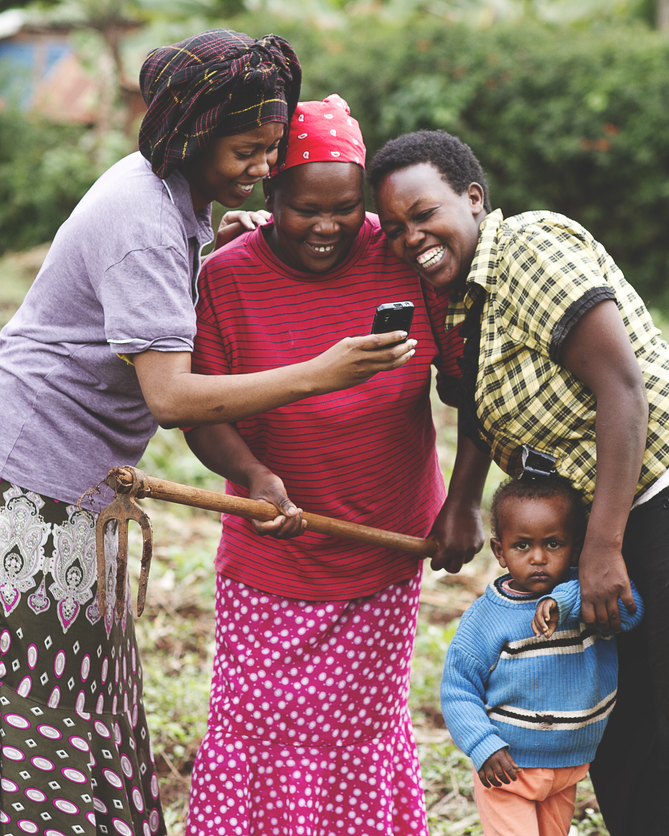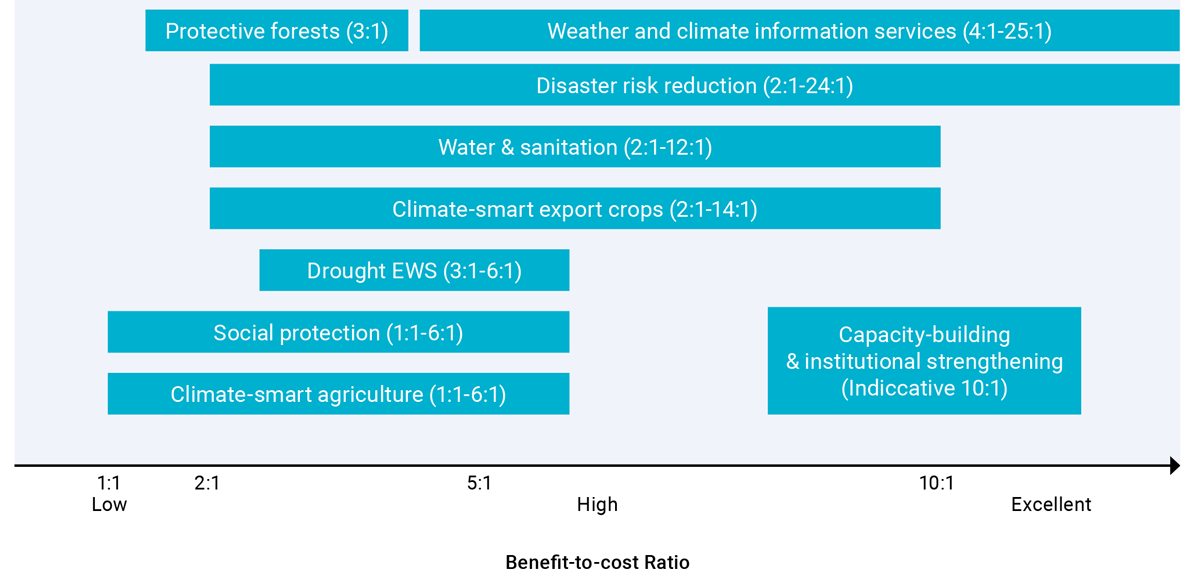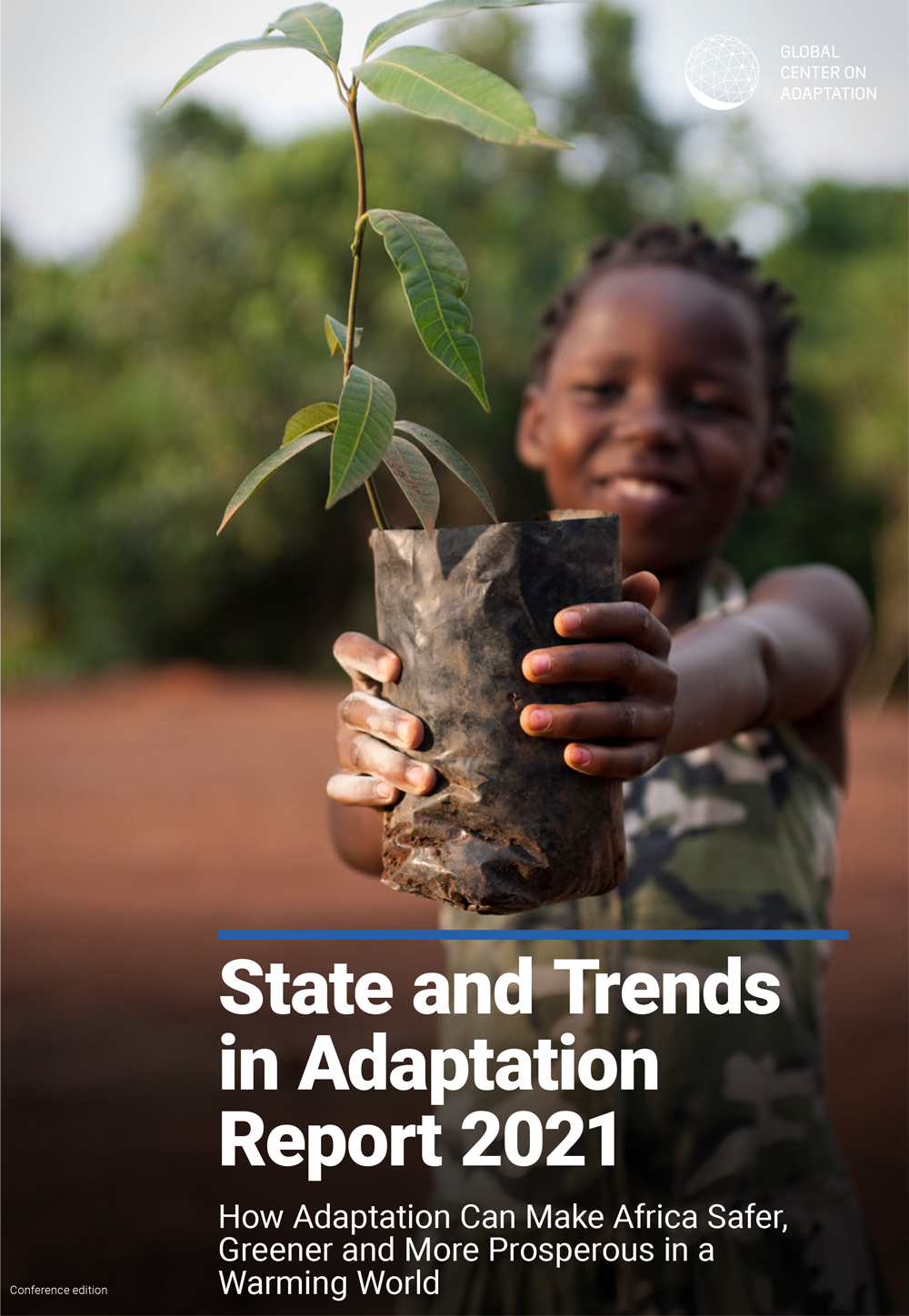CEO’s End of the Year Letter
Distinguished Friends and Colleagues:
COP26 was without a doubt the most anticipated and attention-grabbing international meeting in years. The scene was set by the IPCC’s shock warning in August that certain impacts, such as extreme heat spells, would double by 2030 as we knock on the door of 1.5 degrees Celsius of planetary warming. I want to thank the UK COP26 Presidency for their strong partnership in Glasgow and beyond. I am writing to share with you my views on what the COP delivered for the adaptation agenda, to review how the GCA and our adaptation community contributed to that outcome, and to outline our next steps for 2022. This is certainly a perfect moment to reflect on how going forward, we can work together to ensure adaptation action on the ground matches, if not exceeds, global commitments at the United Nations.
COP26 Outcome: A Step Change for Adaptation
What is for sure is that COP26 delivered a clear step forward for adaptation. Looking back at COP21, it is especially clear that the awareness of the urgency, and value of, climate adaptation has matured significantly in the six years since Paris. Adaptation taking second stage to mitigation has been no more glaring than in the imbalance of financial prioritization of adaptation in international climate finance that prevailed prior to Glasgow.
The step-change delivered by COP26 is, as such, no more obvious than in the decision for developed countries to double adaptation finance by 2025, which will have a transformational effect in scaling adaptation action globally. Alongside this major decision was the further COP26 outcome to attribute 5% of proceeds from the newly established international carbon market mechanism by way of additional support for the adaptation efforts of the most vulnerable nations.
Adaptation finance wins in the COP26 outcome reflected recent developments at the international level, including the five new governments who joined the Champions Group for Adaptation Financing. Increased funding for adaptation was announced or confirmed in Glasgow by Denmark, Japan, Norway, Sweden, UK, USA, and others. Heading into Glasgow, virtually every government submitting an updated Nationally Determined Contribution (NDC) under the Paris Agreement took the opportunity to strengthen the ambition of their adaptation targets and programs.
COP26 outcomes on mitigation are also good news for adaptation in the longer-term, acknowledging more work lies ahead. The decision for all nations to review their 2030 emission targets by next year, together with an annual high-level roundtable on pre-2030 ambition, represent a shift in the ambition cycle towards the need to constantly work on ambition. Keeping 1.5ºC alive depends on it. Inside this now constantly escalating climate emergency, the same shift to continually review ambition is also vital for adaptation. That perspective likewise sets the stage for what COP27 could deliver to further consolidate what was accomplished for adaptation in Glasgow
How the GCA Shaped the Adaptation Agenda in Glasgow
Many of our community joined the inaugural Friends of GCA High-Level Dialogue focused on the Adaptation Imperative for COP26 in early September. At that Dialogue, over fifty leaders from the international climate and development community made it clear that COP26 needed to take decisive action to prioritize adaptation on an even footing with mitigation. This was laid out in a Communique from the Dialogue highlighting the urgency of balancing climate finance, of shifting the climate crisis ambition-raising exercise to a continuous process, and of investing in action-driving partnerships. GCA was at the front line of action-forcing activities.
The Adaptation Imperative for COP26
No posts found
At COP26 itself, the GCA-organized Africa Adaptation Acceleration Summit, held as part of COP26’s World Leaders Summit, was an unprecedented gathering of global leaders on climate adaptation. The Africa Adaptation Acceleration Program (AAAP), a flagship GCA program with the African Development Bank (AfDB), was once more center of attention at this Summit as a practical, functioning vehicle to drive accelerated mobilization of adaptation actions across Africa. Presiding the Summit, H.E. President Félix Tshisekedi, President of the Democratic Republic of Congo, as Chairperson of the African Union, outlined the US$6 billion in financial commitments for climate adaptation African countries have put forward in their NDCs and urged the rest of the world to continue to step up and bring the additional US$27 billion a year the continent requires.
Africa Adaptation Acceleration Summit
As Managing Partner of the Climate Vulnerable Forum (CVF), the GCA also supported the preparations of the most climate threatened nations for COP26, culminating in the CVF Leaders’ Dialogue at COP26, which was chaired by the Bangladesh Prime Minister, H.E. Sheikh Hasina, and resulted in the Dhaka-Glasgow Declaration. That Declaration was particularly influential in shaping the outcome of COP26, as evidenced by the degree to which the most crucial elements of the Glasgow outcome mirrors the CVF’s declaration for COP26: the cementing of a “Pact” to restore confidence in the Paris regime, a shift to constant ambition reviewing, recommitment on the US$100 billion delivery and the balancing of climate funding, the 5% proceeds from carbon markets to support adaptation for the most vulnerable, and the mandate to explore financing options for loss and damage.
The GCA’s work with key partners at Glasgow echoed the ambition of developing countries and most vulnerable, in particular as was evident by the dozens of ministers presenting ambitious new adaptation initiatives, solutions and partnerships at the COP26 Ministerial Dialogue on Adaptation Action. In partnership with the COP26 Presidency, the co-convening by GCA of a dedicated high-level plenary platform on accelerating adaptation action has clearly proven a must-have element for any future COP.
Ministerial Dialogue on Adaptation Action
GCA will continue to work with Egypt, the African Union, and the COP26 Presidency to ensure the drive for enhanced financing, ambition and partnerships for adaptation will continue through and beyond COP27 next year. GCA will be at the front of bringing innovation and spurring adaptation at the country and project levels.
From Global Stage to Action: Africa Adaptation Acceleration Program
Any successes at UNFCCC COPs amount to nothing if adaptation action on the ground is not being realized, scaled and accelerated. Given the step-change that COP26 has set in motion for adaptation, it is all the more important that action on the ground builds up quickly and effectively. That is why GCA has been working throughout 2021 to develop the most ambitious and effective programming and partnerships possible to drive action within vulnerable communities. We also have to shape and prepare what will be a fast-growing pipeline to deliver on all the new international ambition for the adaptation agenda.
Such efforts are reflected in our analytical work and the flagship report on State and Trends in Adaptation 2021, which combines in-depth analyses, case studies, and viewpoints from those on the frontlines of climate change impacts in Africa. It presents a detailed blueprint for action: offering innovative adaptation and resilience ideas, solutions, and policy recommendations. Our effort is also well mirrored in our flagship Africa Adaptation Acceleration Program, the AAAP. In partnership with the African Development Bank, the AAAP, as an African-owned and African-led program, will accelerate momentum by supporting large-scale proof-of-concept investments that can be replicated throughout the continent.

Responding to the needs of African governments and communities, the AAAP focuses on four areas where it can deliver the greatest impact:
- climate smart agriculture
- resilient infrastructure with a focus on nature-based solutions
- youth empowerment for entrepreneurship and job creation in adaptation and resilience
- innovative financial initiatives to unlock additional sources of funding
As the largest and most comprehensive initiative to support African countries for a faster and stronger Covid-19 climate-resilient economic recovery, the US$25 billion AAAP sets the standard for the increased level of financing to provide more impact on the ground.
The AAAP has already begun implementation, which is delivered through two mechanisms. First, the AAAP Investment Facility to finance the projects and programs developed under the four pillars of the AAAP, bringing in multiple financing sources through innovative financial instruments. Second, the AAAP Upstream Facility, hosted by the GCA, to support transformational adaptation shifts at the country level, the supporting research and monitoring for rapid extraction and replication of lessons, and the policy support to steer the economic directions at the national and regional level. Through the AAAP Upstream Facility, the GCA works as a solutions broker to identify and scale adaptation measures in African countries by bringing the best global and regional knowledge and expertise to implement the AAAP projects financed with AfDB, the European Investment Bank (EIB), and other development partners.
Endorsement and commitment to the AAAP Upstream Facility from the global leaders included a new commitment of £20 million for 4 years from the UK’s Foreign, Commonwealth and Development Office to the Upstream Facility. With these funds now able to influence the billions being mobilized as part of downstream investments, meeting the total resource envelope of US$250 million required for the Upstream Facility for the first five years has become a key target for the ‘African COP’ and the elevated ambition on adaptation required at Sharm El-Sheikh.
AfDB has already committed half of the $25 billion sought by the program by 2025 to support Africa’s adaptation plans. With an initial pool of funds, GCA is providing technical support to AfDB project teams, developing partnerships with financiers to expand the financial resource envelope for Africa’s adaptation, and identifying development projects with other financiers in the region to bring adaptation sharper into their focus. Through these actions, GCA has already influenced the design of the first billion dollar of investments of AAAP by bringing the best adaptation science and knowledge. The Technical Assistance Program (TAP) within the AAAP Upstream Facility is also enabling African countries to directly access finance from international funds like the Green Climate Fund (GCF), with an estimated GCF resource mobilization of over US$150 million in Burkina Faso, Democratic Republic of Congo, Nigeria, and Niger.
GCA will continue to support AAAP partner countries to put forward effective national adaptation projects to these funds. Examples of the country projects GCA is engaged in with AfDB project teams include the Regional Project for Building Sustainable Food Systems in the Horn of Africa (US$370 million) comprising Kenya, Ethiopia, Djibouti, Somalia, Sudan, and South-Sudan; the Mkondvo Ngwavuma Water Augmentation Program Phase I and II (US$332 million) in the Kingdom of Eswatini; and the Integrated Cereal-Animal Protein Value Chain Development & Resilience Project (US$40 million) in Burkina Faso. GCA and AfDB teams have also been working to support the cities of Accra, Bizerte, Conakry, Libreville, Antananarivo, and Dodoma with rapid climate risk assessments and adaptation and resilience investment prioritization and planning.
State and Trends in Adaptation Africa 2021:
Generating Frontier Knowledge and Policy Analysis
GCA indeed underpins its work in programs such as the AAAP with the scientific and analytical capabilities of our policy and research teams. In a short period of time, GCA has emerged at the cutting edge of climate adaptation analytics and knowledge development, which is absolutely crucial to ensure that the global scaling-up of financing for adaptation is as effective and impactful as possible. Evidence-based knowledge will continue to guide the implementation and further shaping of the AAAP, for example, as is the case with all GCA programming. Just prior to COP26, and inaugurated by President Kenyatta of Kenya, GCA published the most comprehensive analysis of climate change risks and adaptation solutions in Africa – the “State and Trends in Adaptation in Report 2021 (STA21) – How Adaptation Can Make Africa Safer, Greener and More Prosperous in a Warming World.” GCA, leveraging its global knowledge brokering role, mobilized a large coalition of African and international knowledge and development partners to produce this report.
Launch of “State and Trends in Adaptation Report 2021: Africa”
No posts found
The report shows the very serious consequences of global warming at and beyond 1.5°C, particularly given the impacts of climate change are already locked in over the next decade. This makes adaptation a priority of utmost urgency for the African continent. Without adaptation action, our projections estimate that climate change will lead to an equivalent of 2% to 4% annual loss in GDP on the continent by 2040, with the poor, women, and excluded populations bearing the brunt of the impact. As part of STA21, a detailed review of Africa-specific studies on the cost-benefit ratios of early adaptation actions was conducted. The results are shown in Figure 1: the benefit-to-cost ratios for adaptation investments are always positive and reach as high as 25:1.
Figure 1: Adaptation benefit-to-cost ratios for selected options from an extensive group of Africa-specific studies

The STA21 report analysed the projected climate change impacts on African economies in a variety of sectors, from agriculture to infrastructure, water, and cities. It examines the opportunities that drylands offer for a more resilient and sustainable economic growth. The report shows that the cost of adaptation action in agriculture in Sub-Saharan Africa is about US$15 billion a year, but the cost of inaction (when accounting for all costs) is as high as US$200 billion per annum, which highlights just how compelling the investment case for adaptation in Africa is. The STA21 report also looks at the opportunities of jobs for adaptation, the role of trade as an adaptation tool, and the benefits of empowering women in adaptation action. It also reviews the latest research on climate change pathways to migration and conflict.
Looking Ahead: Scale Up Adaptation Globally
Right now, GCA’s immediate top focus is on increasing delivery on the ground in Africa through AAAP. To achieve the full potential of this program, we are keen to expand the financing partners engaged in the AAAP, and the number of countries where adaptation projects are implemented at scale.
We will also continue pushing the envelope on science, knowledge, and policy. With COP27 taking place in Egypt, our State and Trends in Adaptation report in 2022 will continue the analysis of adaptation issues in Africa. The needs for frontier knowledge and policy advice are enormous in so many areas of adaptation, and the STA series is designed to progressively work on them. It is vital that GCA continues to remain at the forefront of scientific, technical, and policy adaptation knowledge in order to provide the best support through our partnerships to drive effective, accelerated adaptation action.
As the AAAP working model is showing its first fruits, we need to be clear that the ambition and approach of AAAP is needed in every vulnerable region of the world today. That is why the GCA has already been laying foundations beyond Africa to carry the momentum of AAAP into other regions while, of course, ensuring needs specific to each region are incorporated as we move forward. 2022 will see the launch of GCA’s South Asia program, and the exploration of a third region or group of countries for launch in 2023.
In fact, there is mounting evidence that adaptation implementation has been considerably impeded by the direct and indirect effects of the Covid-19 pandemic and responses to it. On the other hand, unlocking bold adaptation action will galvanize the pandemic recovery by protecting economies and communities from the fast-escalating climate crisis that everyone today faces. Indeed, Covid-19 clearly compounded the impact of climate disasters in 2020 and 2021. The silver lining is that the first AAAP projects are already demonstrating real potential to contribute to the economic recovery. We need to build on that.
The GCA is also working with key partners at the international and regional levels to ensure that the best and most impactful investments will materialize as rapidly as possible. At COP26 we signed an important Memorandum of Understanding with the European Investment Bank (EIB), for instance, to enable the EIB’s important investments relating to resilience to also benefit from direct expertise and support of GCA teams moving forward. We are likewise doing the same with UN agencies such as the International Fund For Agricultural Development (IFAD), and have begun similar dialogues with the World Bank Group to help evolve their portfolio and investment operations worldwide in the most effective possible manner.
I want to also highlight the cross-cutting emphasis the GCA is placing on youth as we move forward in all these areas. I encourage you to explore the laureates of our first round of competitive grants awarded to 10 young African entrepreneurs at COP26. Empowering innovative enterprises and creating jobs for young people will be an important positive system catalyst for action beyond standard climate programs. The GCA Africa Youth Climate Council I launched together with President Akinwumi Adesina of the AfDB at COP26 will likewise ensure the transformative potential of young people can be integrated across the AAAP, while similar initiatives will also be put forward in all GCA regions.
Youth Adaptation Solutions Challenge (YouthADAPT)
Next year’s COP27 will be the Africa COP. I am just returning from a country mission to the Democratic Republic of the Congo where I was delighted to accept President Tshisekedi’s invitation for the GCA to act as a principal partner in an adaptation-focused pre-COP they will host in advance of the main Sharm El-Sheikh meeting. Likewise, we will continue to work on promoting maximum adaptation ambition, mobilizing financing, and leveraging effective partnerships at and beyond the UNFCCC, including through the proposal to co-host a second high-level adaptation ministerial at COP27 together with the incoming COP presidency of Egypt.
I would also like to invite you all to tentatively save-the-date on 5th September 2022 for a second, annual Friends of GCA Adaptation High-Level Dialogue at our floating headquarters in Rotterdam. I believe all of us would like to build on the success of the first of these dialogues this year, seeing the positive follow-up from that event, both in the outcomes of COP26 and for the many implementation partnerships we have helped forge together. I have no doubt that your renewed participation in the 2022 edition of this High-Level Dialogue will reaffirm its function as a primary international forum for adaptation policy and investment. I aim to work with all our partners to also ensure the 2022 Dialogue will be a launchpad for a further ambitious outcome on adaptation at the Africa COP27.
At GCA, our impact on those living on the frontlines depends on the quality of our team. We will have a significant shift next year with a higher number of technical staff set to join the organization. We have worked hard in 2021 to demonstrate the potential of the AAAP vision and several donor partners have provided initial resources for our work. There is building momentum but still much ground to cover for mobilizing all of our AAAP Upstream Facility target of US$250 million. 2022 will be a critical year to deepen and expand our partnerships and funding for impact on the ground.
In closing, I would like to thank all of you for your continued support and partnership. Adaptation is a defining challenge of our generation. The Covid-19 pandemic has been relentless and its health and economic impacts devastating. Only together can we address the triple challenges of Covid-19, economic recovery, and climate adaptation in 2022. It’s going to be hard, but hard is not impossible.
Warmly,
Patrick

Prof. Dr. Patrick Verkooijen
Chief Executive Officer
Global Center on Adaptation
